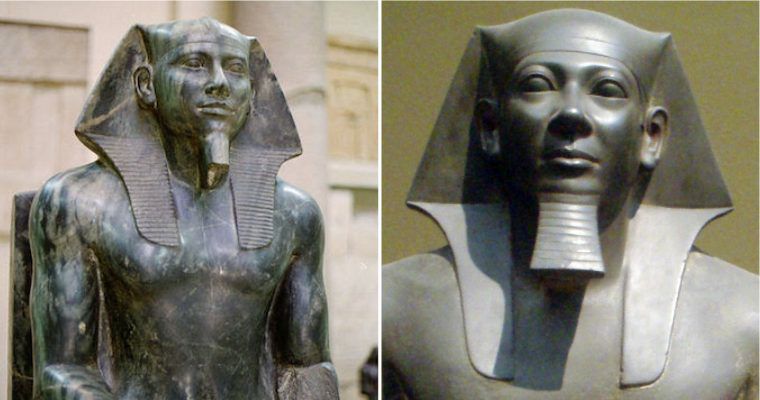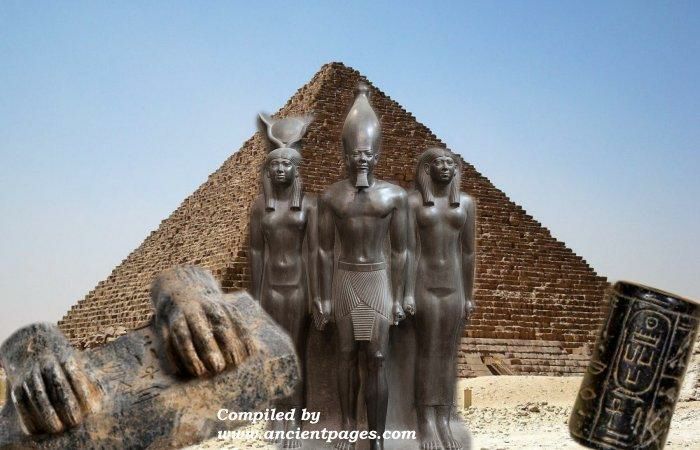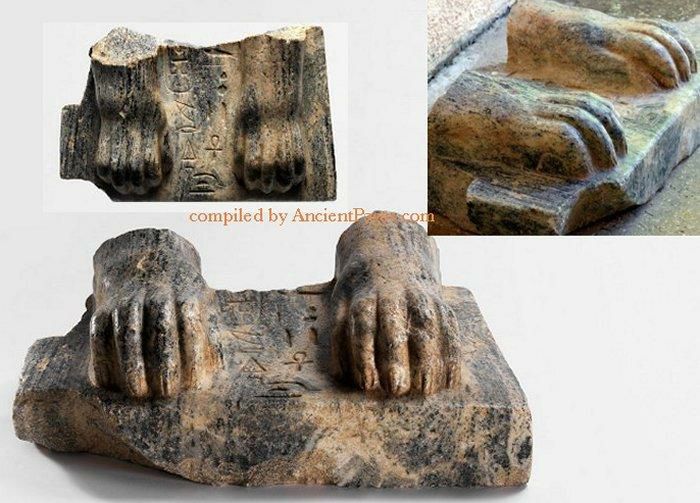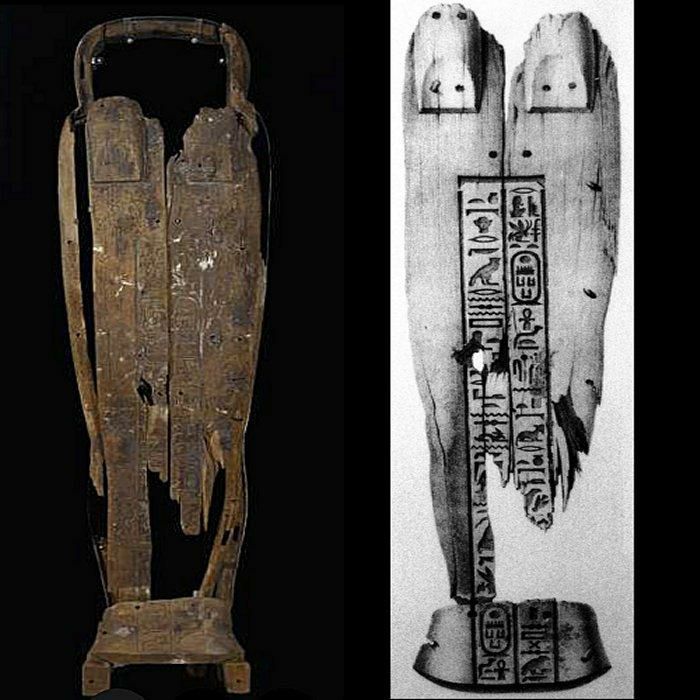Pharaoh Menkaure was an Egyptian ruler who tried to overcome fate.
The Giza pyramids are associated with three pharaohs: Khufu, Khafre, and Menkaure. Unfortunately, these magnificent structures were looted and vandalized by criminals and thieves a long time ago. The southernmost pyramid is attributed to Menkaure, also known as Mykerinos in Greek, who was the fifth king of the 4th Dynasty.
Very little is known about this ruler, and the main source mentioning Menkaure, although not always reliable, is the account of Herodotus and some legendary tales.
Menkaure was the eldest son of Pharaoh Khafre and the grandson of Khufu (Cheops). He reigned during the middle of the third millennium BC, approximately from 2490 to -2473, although the exact duration of his reign remains uncertain. His wives were Queens Khamerernebty II and Rekhetre, while Shepseskaf, possibly his son, succeeded Menkaure.
Menkaure’s relationship with his daughter was extremely troubled. According to Herodotus, he forced himself upon his daughter, and when she could no longer bear the shame, she took her own life. The Pharaoh was forever haunted by grief and guilt.
Menkaure became renowned for his pyramid tomb at Giza and his beautiful statue triads, depicting the king alongside goddesses and his wife, Khamerernebty. In contrast to his grandfather, Khufu, Menkaure left behind numerous statues and high reliefs that provide us with a glimpse into his appearance. The most famous of these depictions is the triad, a high relief showcasing Menkaure alongside the goddess Hathor and the personification of a nome, a provincial entity.
Evidence suggests that Menkaure was venerated even during the 26th Dynasty, as his name was discovered on scarabs from that period.
The available material evidence concerning Menkaure’s reign consists mainly of fragments of vessels inscribed with his name.
A fragment of a sphinx bearing the name of King Menkaure (Mycerinus) was unearthed in Late Bronze Age Hazor, Israel, in a context that postdates Menkaure’s rule by over a thousand years.
During the reigns of Khufu and Khafre, Egypt endured severe calamities. Temples were closed, and both free citizens and slaves toiled tirelessly day and night, constructing pyramids for their rulers.
Menkaure brought about significant changes for the people by reopening the temples and alleviating restrictions on the impoverished populace. He allowed them to work in their fields and offer sacrifices. He was regarded as the most righteous ruler of all. The Egyptians adored him and struggled to express their gratitude to the gods for sending such a just, kind, and wise Pharaoh.
The first tragedy that befell Menkaure was the death of his beloved daughter, who took her own life. Subsequently, the Oracle of Buto prophesied that Menkaure would live for only six more years.
Upon hearing this prophecy, the Pharaoh dispatched messengers to seek answers from the oracle Maat. The messengers posed the following question to the goddess of cosmic order:
“The great Menkaure’s father and grandfather closed the temples, disregarded the gods, oppressed the people, and lived long lives. Why should a pious and benevolent Pharaoh meet his end in six years?”
Sepulchral Chamber of Men-ka-ra. Men standing in a high-ceilinged tomb chamber.
Is it fair? The messengers posed this question, and Maat, the ancient Egyptian concept of justice and balance, provided her answer:
“Menkaure was a kind and fair ruler, and that’s precisely why I shortened his life. He failed to fulfill his obligations, and as a result, Egypt was destined to suffer calamities for 150 years. Khufu and Khafra understood this, but Menkaure did not comprehend it.
Had he abandoned his acts of goodness and transformed into a cruel and unjust ruler, Maat might have reconsidered her verdict. She had spared Pharaoh Khufu, who attempted to defy fate.
Outsmarting destiny is a formidable task, but Menkaure dared to try. He devised a strategy to extend his remaining years by turning night into day. By lighting candles as night fell, he persisted in living both day and night, indulging in drink and entertainment. His plan was to double his remaining time from six to twelve years.” (Herodotus, Histories, 2.129-133).
In theory, he sought to prolong his reign to twelve years. However, the gods could not be deceived, and according to legend, Menkaure met his demise after the six years stipulated by the calendar.
The Pharaoh passed away before completing his pyramid. Some accounts suggest that Menkaure governed for a total of twelve (or eighteen) years, providing ample time to construct his pyramid to match the grandeur of the other two pyramids at Giza. However, he did not do so. Additionally, a magnificent series of slate triads remained unfinished, with the majority discovered in various stages of completion. It is possible that Menkaure lacked sufficient time to oversee the construction projects.
According to the preserved legends, his death was sudden.
Menkaure’s unfinished pyramid was not taller than those of his father and grandfather, but its facing stones were beautifully polished, a feature that remains visible to this day.
On the left: Fragments of the lid from a wooden coffin, likely associated with a restoration of the burial from the 26th Dynasty. The inscriptions on the wooden coffin identify the owner as “Osiris Menkaure, to whom eternal life was given, born from heaven, from the sky goddess Nut above you…” The coffin and skeletal remains are now housed in the British Museum. On the right: A drawing of the anthropoid coffin fragment inscribed with the name of King Menkaura, made by excavator Richard Vyse and published in 1840. Source
The facing stones exhibit a certain level of smoothness, followed by curves. Menkaure’s pyramid boasts an exceptional interior design. Most of the structure’s interior spaces are situated below ground level, with the burial chamber itself carved into the rock, located as deep as 15.5 meters beneath the pyramid’s base.
Such an accomplishment must have been extraordinary. There was also a cedar coffin, adorned with relief decorations depicting the side view of a royal palace and the complex of the Pyramid of Djoser in Saqqara.
Within the pyramid lies an additional, seemingly false burial chamber. The entrance begins approximately four meters above the ground, and from there, a descending corridor leads to ground level. Continuing through a horizontal passage, one arrives at a chamber that stands four meters high. The purpose of this decoy section was to deceive potential thieves. Only from this room does a sloping tunnel lead to the genuine burial chamber.
In 1837, archaeologist Howard Vyse and his team made an intriguing discovery. They stumbled upon a burial chamber containing several intriguing artifacts: an empty sarcophagus crafted from basalt, a coffin lid shaped like a mummy made of wood, and a collection of bones. After further examination, these bones were determined to date back to the early Christian era and had no connection to Pharaonic times.
The basalt sarcophagus, however, raised the possibility that it could have belonged to Menkaure. Unfortunately, no one had the opportunity to examine it closely. Following its discovery, the sarcophagus was carefully loaded onto the ship Beatrice and set sail for the British Museum in London, where it was intended to be displayed. Sadly, fate had a different plan.
Tragedy struck in 1838 when the Beatrice sank off the coast of Spain, dragging the valuable cargo down to the bottom of the Mediterranean Sea. The wooden mummy-shaped coffin, however, managed to reach its intended destination at the British Museum. Despite numerous efforts to locate the shipwreck and the lost basalt sarcophagus of Menkaure, all attempts proved fruitless.
The sea has claimed numerous vessels throughout history, and the Beatrice was just one of its victims. Thankfully, the wooden coffin successfully made its journey to the museum on another boat, ensuring that at least part of the discovery could be shared with the public.
Hits: 0







